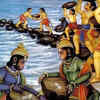The Truth About the Ram Setu: Science vs. Mythology
The Ram Setu, often referred to as "Adam's Bridge," ranks among the most intriguing and debated locations in India. Stretching across the Palk Strait that divides India from Sri Lanka, this collection of natural limestone shoals has sparked significant discussion and interest. While it carries deep mythological significance, it concurrently presents a scientific puzzle that has bewildered experts for years. However, what is the truth regarding the Ram Setu? Is it a natural formation, or is there more to it than that?
The Mythological Significance

Image Source : Pixabay
According to Hindu mythology, the Ram Setu is no ordinary geological formation. In the ancient Indian epic, the Ramayana, the bridge is said to have been built by Lord Rama’s army of monkeys to rescue his wife, Sita, from the demon king Ravana in Lanka. It’s described as a floating bridge that enabled Rama’s forces to march across the ocean and launch their final assault.
For millions of people, the Ram Setu holds immense religious and cultural importance. The idea that this structure, mentioned in one of the most revered epics of all time, was physically built by divine forces gives it a spiritual aura that transcends the ordinary. For devotees, the belief that the bridge was constructed by Lord Rama's army is an unquestionable truth, one that continues to inspire awe and reverence.
The Scientific Perspective: Nature’s PuzzleFrom a scientific perspective, the Ram Setu is a natural structure, consisting of sandbanks and coral reefs. These sandbars and shoals are frequently thought to belong to the submerged landmass that previously linked India and Sri Lanka. Numerous studies indicate that the formation arose from natural mechanisms like sediment deposition, coral growth, and erosion over millennia.
One of the most persuasive pieces of evidence presented by scientists is the age of the Ram Setu. Some research indicates that the bridge dates back more than 7,000 years, emerging during an era when sea levels were much lower. This reinforces the notion that it was formed by the natural geological processes of the region, instead of being a result of any divine action.
In fact, satellite imagery and underwater research have confirmed the presence of this submerged formation, supplying additional proof that it is a natural phenomenon. The peculiar configuration of the shoals, however, has prompted some to ask: Might the Ram Setu have been altered or improved by human intervention at some time in history?
The Clash: Science vs. Mythology

While science provides its interpretations for the formation of the Ram Setu, the discussion does not fully end there. The legends related to the bridge, although not demonstrable within a scientific framework, continue to hold importance for millions of Hindus who see it as proof of divine involvement in ancient times. For them, the bridge transcends being merely a geological feature—it symbolizes the strength of Lord Rama and the forces that fought alongside him.
Conversely, skeptics contend that associating the Ram Setu with the Ramayana could merely be an outcome of ancient storytelling, lacking a genuine connection to the tangible world. They reference the natural formation of the shoals and coral reefs as proof that the bridge is fundamentally a natural phenomenon, not a human-made or divine artifact.
What Do We Really Know?
So, what is the reality behind the Ram Setu? Is it a natural structure or a piece of mythological lore? The response could involve elements of both. While scientific interpretations strongly support its natural beginnings, the cultural and spiritual importance of the Ram Setu cannot be overlooked. Whether you see it as the handiwork of divine beings or merely a naturally formed occurrence, the Ram Setu continues to enchant the minds of millions.
The ongoing discussion surrounding the Ram Setu highlights that science and mythology do not always have to conflict. In certain instances, they can exist together, each providing a distinct viewpoint on the same subject. Whether it represents Lord Rama’s victory or a geological marvel created by natural forces, the Ram Setu remains an intriguing enigma that encourages us to investigate both history and the current moment.
The Ram Setu will forever be a representation of both awe and enigma. While science can clarify the creation of the bridge through natural mechanisms, the mythological meaning of the Ram Setu will persist in holding significance in the hearts and minds of countless individuals. Whether you perceive it as a miraculous act of divine influence or as an intriguing natural structure, it’s undeniable that this remarkable landmark possesses immense historical and cultural value.
Contact to : xlf550402@gmail.com
Copyright © boyuanhulian 2020 - 2023. All Right Reserved.